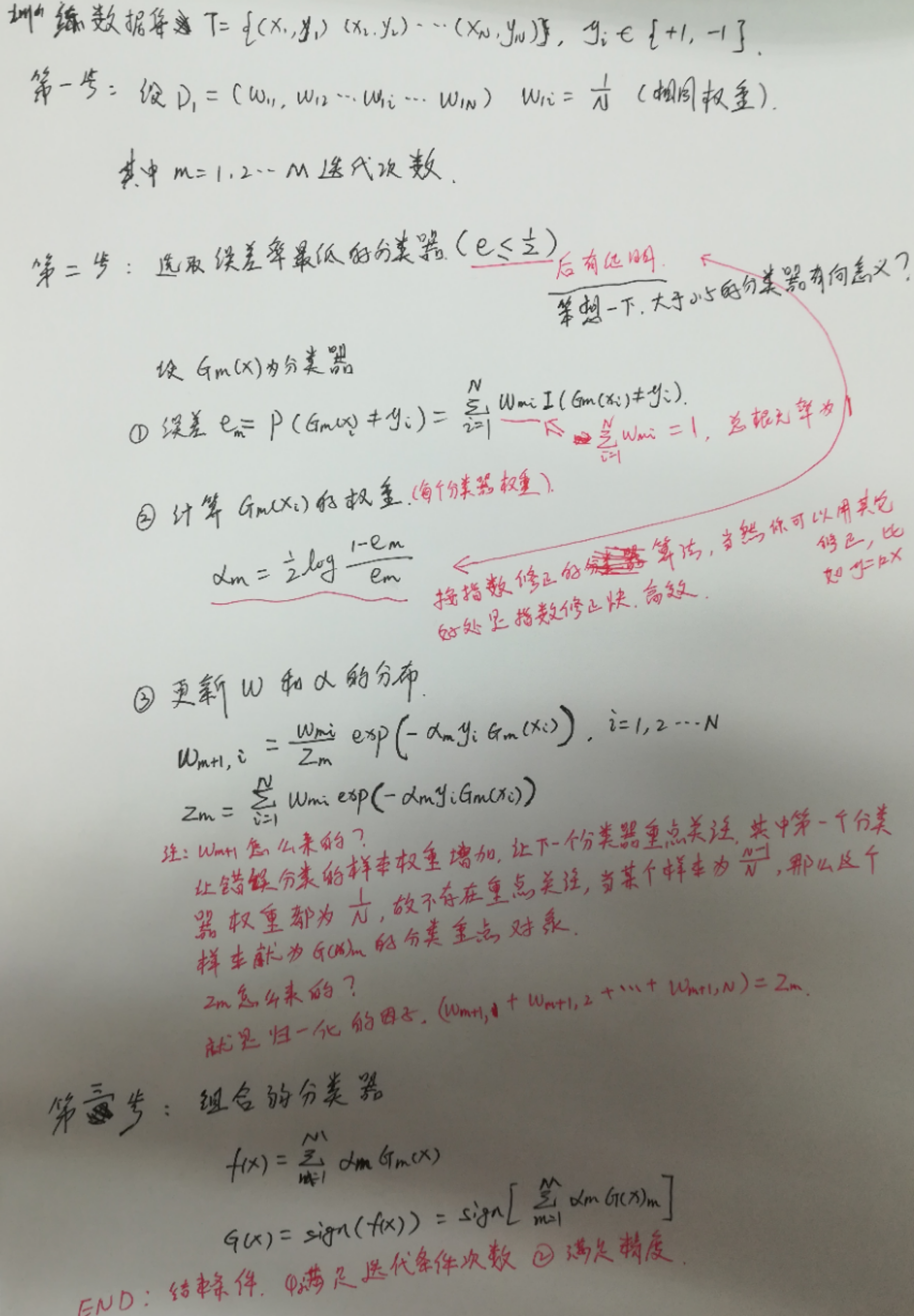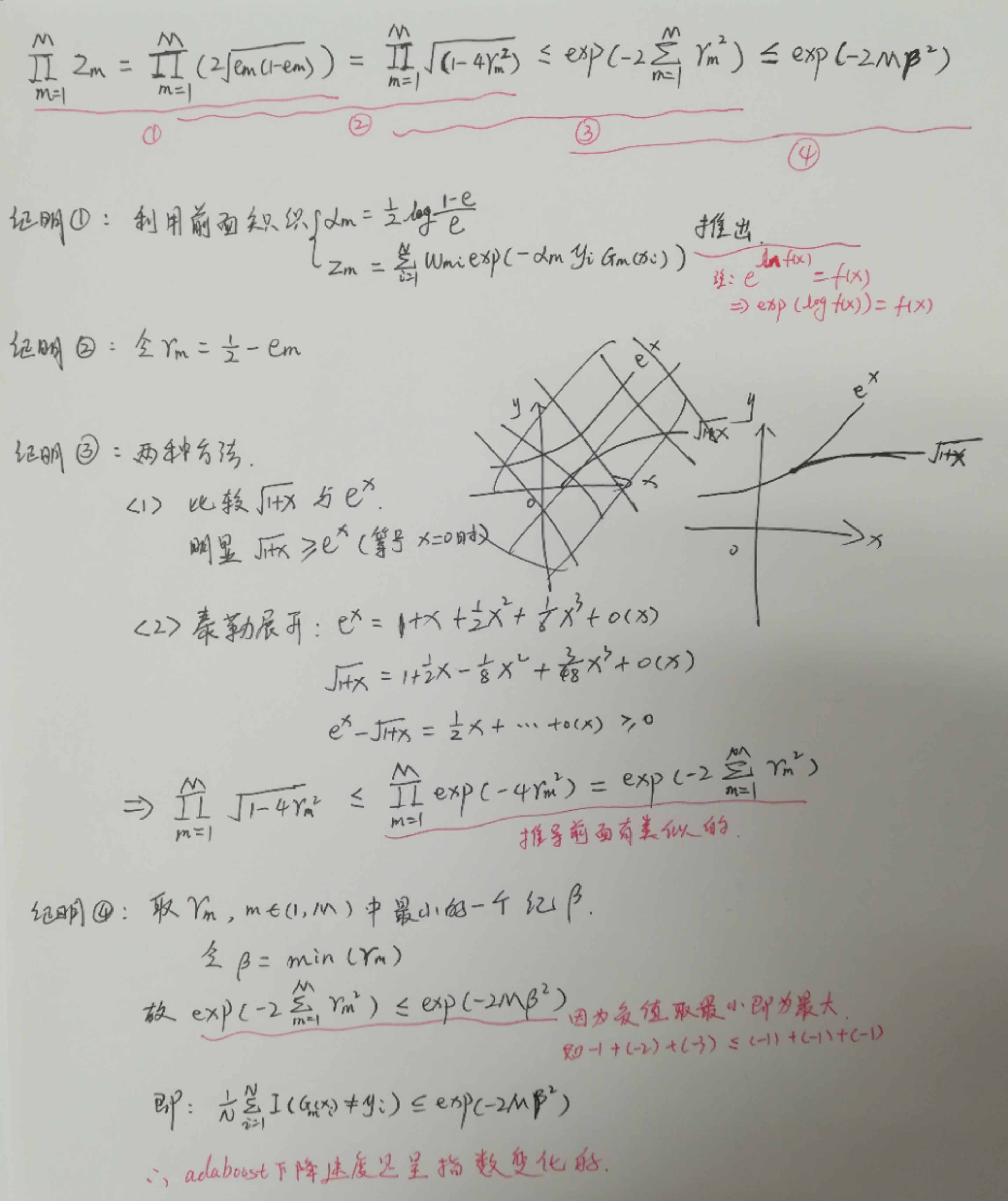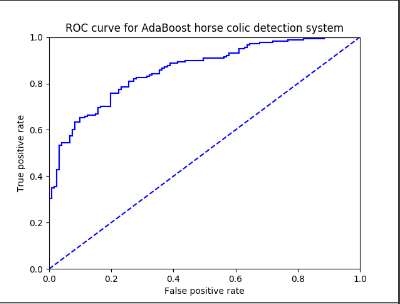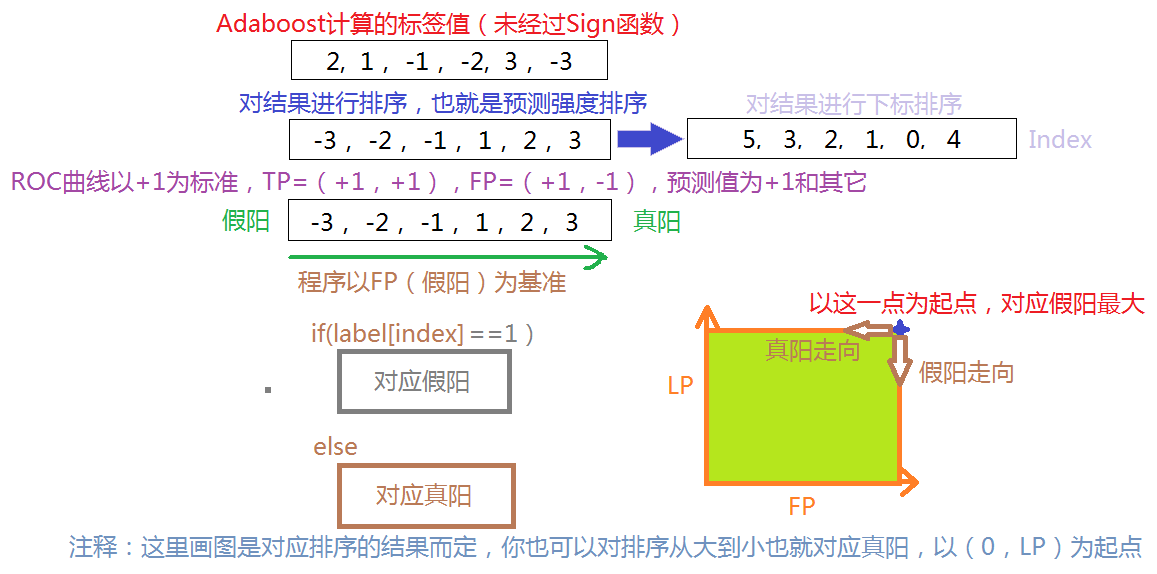Adaboost:多个弱分类器组成一个强分类器,按照每个弱分类器的作用大小给予不同的权重
|
一.Adaboost理论部分
1.1 adaboost运行过程
注释:算法是利用指数函数降低误差,运行过程通过迭代进行。其中函数的算法怎么来的,你不用知道!当然你也可以尝试使用其它的函数代替指数函数,看看效果如何。

1.2 举例说明算法流程
略,花几分钟就可以看懂的例子。见:《统计学习方法》李航大大
博客都是借鉴(copy)李航博士的:http://blog.csdn.net/v_july_v/article/details/40718799 ,July算总结(copy)最好的吧!
1.3 算法误差界的证明
注释:误差的上界限由Zm约束,然而Zm又是由Gm(xi)约束,所以选择适当的Gm(xi)可以加快误差的减小。

二.代码实现
注释:这里参考大神博客http://blog.csdn.net/guyuealian/article/details/70995333,举例子很详细。
2.1程序流程图

2.2基本程序实现
注释:真是倒霉玩意,本来代码全部注释好了,突然Ubuntu奔溃了,全部程序就GG了。。。下面的代码就是官网的代码,部分补上注释。现在使用Deepin桌面版了,其它方面都比Ubuntu好,但是有点点卡。
1 from numpy import * 2 3 def loadDataSet(fileName): #general function to parse tab -delimited floats 4 numFeat = len(open(fileName).readline().split(' ')) #get number of fields 5 dataMat = []; labelMat = [] 6 fr = open(fileName) 7 for line in fr.readlines(): 8 lineArr =[] 9 curLine = line.strip().split(' ') 10 for i in range(numFeat-1): 11 lineArr.append(float(curLine[i])) 12 dataMat.append(lineArr) 13 labelMat.append(float(curLine[-1])) 14 return dataMat,labelMat 15 16 def stumpClassify(dataMatrix,dimen,threshVal,threshIneq):#just classify the data 17 retArray = ones((shape(dataMatrix)[0],1)) 18 if threshIneq == 'lt': 19 retArray[dataMatrix[:,dimen] <= threshVal] = -1.0 20 else: 21 retArray[dataMatrix[:,dimen] > threshVal] = -1.0 22 return retArray 23 24 25 def buildStump(dataArr,classLabels,D): 26 dataMatrix = mat(dataArr); labelMat = mat(classLabels).T 27 m,n = shape(dataMatrix) 28 numSteps = 10.0; bestStump = {}; bestClasEst = mat(zeros((m,1))) 29 minError = inf #init error sum, to +infinity 30 for i in range(n):#loop over all dimensions 31 rangeMin = dataMatrix[:,i].min(); rangeMax = dataMatrix[:,i].max(); 32 stepSize = (rangeMax-rangeMin)/numSteps 33 for j in range(-1,int(numSteps)+1):#loop over all range in current dimension 34 for inequal in ['lt', 'gt']: #go over less than and greater than 35 threshVal = (rangeMin + float(j) * stepSize) 36 predictedVals = stumpClassify(dataMatrix,i,threshVal,inequal)#call stump classify with i, j, lessThan 37 errArr = mat(ones((m,1))) 38 errArr[predictedVals == labelMat] = 0 39 weightedError = D.T*errArr #calc total error multiplied by D 40 #print "split: dim %d, thresh %.2f, thresh ineqal: %s, the weighted error is %.3f" % (i, threshVal, inequal, weightedError) 41 if weightedError < minError: 42 minError = weightedError 43 bestClasEst = predictedVals.copy() 44 bestStump['dim'] = i 45 bestStump['thresh'] = threshVal 46 bestStump['ineq'] = inequal 47 return bestStump,minError,bestClasEst 48 49 50 def adaBoostTrainDS(dataArr,classLabels,numIt=40): 51 weakClassArr = [] 52 m = shape(dataArr)[0] 53 D = mat(ones((m,1))/m) #init D to all equal 54 aggClassEst = mat(zeros((m,1))) 55 for i in range(numIt): 56 bestStump,error,classEst = buildStump(dataArr,classLabels,D)#build Stump 57 #print "D:",D.T 58 alpha = float(0.5*log((1.0-error)/max(error,1e-16)))#calc alpha, throw in max(error,eps) to account for error=0 59 bestStump['alpha'] = alpha 60 weakClassArr.append(bestStump) #store Stump Params in Array 61 #print "classEst: ",classEst.T 62 expon = multiply(-1*alpha*mat(classLabels).T,classEst) #exponent for D calc, getting messy 63 D = multiply(D,exp(expon)) #Calc New D for next iteration 64 D = D/D.sum() 65 #calc training error of all classifiers, if this is 0 quit for loop early (use break) 66 aggClassEst += alpha*classEst 67 #print "aggClassEst: ",aggClassEst.T 68 aggErrors = multiply(sign(aggClassEst) != mat(classLabels).T,ones((m,1))) 69 errorRate = aggErrors.sum()/m 70 print ("total error: ",errorRate) 71 if errorRate == 0.0: break 72 return weakClassArr,aggClassEst 73 74 def adaClassify(datToClass,classifierArr): 75 dataMatrix = mat(datToClass)#do stuff similar to last aggClassEst in adaBoostTrainDS 76 m = shape(dataMatrix)[0] 77 aggClassEst = mat(zeros((m,1))) 78 for i in range(len(classifierArr)): 79 classEst = stumpClassify(dataMatrix,classifierArr[i]['dim'], 80 classifierArr[i]['thresh'], 81 classifierArr[i]['ineq'])#call stump classify 82 aggClassEst += classifierArr[i]['alpha']*classEst 83 #print aggClassEst 84 return sign(aggClassEst) 85 86 def plotROC(predStrengths, classLabels): 87 import matplotlib.pyplot as plt 88 cur = (1.0,1.0) #cursor 89 ySum = 0.0 #variable to calculate AUC 90 numPosClas = sum(array(classLabels)==1.0)#标签等于1的和(也等于个数) 91 yStep = 1/float(numPosClas); xStep = 1/float(len(classLabels)-numPosClas) 92 sortedIndicies = predStrengths.argsort()#get sorted index, it's reverse 93 sortData = sorted(predStrengths.tolist()[0]) 94 95 fig = plt.figure() 96 fig.clf() 97 ax = plt.subplot(111) 98 #loop through all the values, drawing a line segment at each point 99 for index in sortedIndicies.tolist()[0]: 100 if classLabels[index] == 1.0: 101 delX = 0; delY = yStep; 102 else: 103 delX = xStep; delY = 0; 104 ySum += cur[1] 105 #draw line from cur to (cur[0]-delX,cur[1]-delY) 106 ax.plot([cur[0],cur[0]-delX],[cur[1],cur[1]-delY], c='b') 107 cur = (cur[0]-delX,cur[1]-delY) 108 ax.plot([0,1],[0,1],'b--') 109 plt.xlabel('False positive rate'); plt.ylabel('True positive rate') 110 plt.title('ROC curve for AdaBoost horse colic detection system') 111 ax.axis([0,1,0,1]) 112 plt.show() 113 print ("the Area Under the Curve is: ",ySum*xStep)

注释:重点说明一下非均衡分类的图像绘制问题,想了很久才想明白!
都是相对而言的,其中本文说的曲线在左上方就为好,也是相对而言的,看你怎么定义个理解!

参考文献:
《统计学习方法》李航
http://blog.csdn.net/v_july_v/article/details/40718799 没有书的就看这个大神的博客,基本是上面那本数的原版